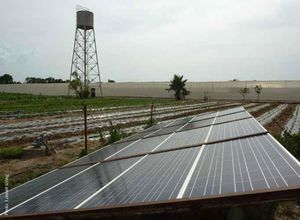Knowledge fuels change
For over a decade, Energypedia has shared free, reliable energy expertise with the world.
We’re now facing a serious funding gap.
Help keep this platform alive — your donation, big or small, truly matters!
Thank you for your support
Difference between revisions of "SPIS Toolbox - Hand-over and Training"
***** (***** | *****) m (Ranisha moved page SPIS Manual – Hand-over and Training – SET UP to SPIS Toolbox - Hand-over and Training without leaving a redirect) |
***** (***** | *****) m |
||
| Line 1: | Line 1: | ||
| − | + | {{SPIS Banner}}{{Back to Set Up}} | |
| − | {{SPIS Banner}} | ||
=== '''<span style="color:#879637;">Hand-over and Training</span>''' === | === '''<span style="color:#879637;">Hand-over and Training</span>''' === | ||
Revision as of 12:48, 9 June 2017

Introduction
Do want to know all about SPIS – Solar Powered Irrigation System : Please go to the newly launched standalone Solar Powered Irrigation Systems (SPIS) website (www.spis-toolbox.org) , featuring three SPIS toolbox:
- Toolbox for beginners,
- Toolbox for farmers (new SPIS Web based App – to calculate design of the pumps),
- the Toolbox for experts - the updated version - Version 6
and additional resources (Publication about SPIS).
The Toolbox on Solar Powered Irrigation Systems (SPIS) is designed to enable advisors, service providers and practitioners in the field of solar irrigation to provide broad hands-on guidance to end-users, policy-makers and financiers. Risks related to system efficiency, financial viability and the unsustainable use of water resources can thus be minimized. The Toolbox comprises informative modules supplemented with user-friendly software tools (calculations sheets, checklists, guidelines). read more
Modules and tools touch upon:
- assessing the water requirements,
- comparing the financial viability,
- determining farm profitability and payback of investment in SPIS,
- sustainably design and maintain a SPIS,
- highlight critical workmanship quality aspects,
- and many more.

style="width: 160px; background-color: rgb(111, 142, 43);" | ►Back to the Module Page
Hand-over and Training
The final step of the installation process is to formally hand over the SPIS to the user (producer). The handing-over is usually combined with a thorough introduction to all technical aspects of the system and a practical training on its operation as per the designed performance. This step should be thoroughly planned because the user should have sufficient time to go through all system components and operation and maintenance aspects together with the technicians of the installer.
Prior to this step, all other requirements should have been completed, in particular the PVP acceptance and the system tests and the system’s documentation. Ideally, the user could accompany and follow the entire installation process including the testing steps. This way they will already have obtained knowledge about their system and will have had the opportunity to be familiarized with the main technical and operational features.
During the testing stages of the installation process, defects or quality problems are identified and recorded and an agreement between the installer and the user is concluded on how and when these defects are corrected. This is laid down in the test protocols. A handing over of the system should not take place before all repairs and amendments are implemented.
The handing-over and the related instruction and training usually take place during a final test run of the system. It should not be done as a theoretical classroom exercise. Supporting material for the training should consist of the operational guidelines and the manual that is provided as part of the system’s documentation.
Important features of the orientation and training are:
- introduction to the specifics of all system components;
- operation of the system under different conditions, in particular crop water distribution management based on pressure and supply duration management;
- security precautions and protection of system components;
- health and environmental hazards;
- emergency procedures;
- maintenance works and schedules.
The handing over should be concluded by signing a hand over protocol that states the condition of the system and all activities carried out to instruct and train the producer.
Outcome/Product
- Hand-over protocol.
Data Requirements
- PVP acceptance and system test data;
- System documentation and operation manual.
People/Stakeholders
- Producer;
- Installation service provider;
- Agricultural service provider.
Important Issues
- Hand over should only take place if the system is perfectly running, with no remaining deficiencies.
- Hand over should be accompanied by a practical introduction and training of the user including information on security precautions, system protection and hazards.
- A hand-over protocol should be prepared and signed.




















